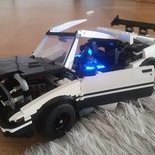-
Content Count
53 -
Joined
-
Last visited
About janssnet

Spam Prevention
-
What is favorite LEGO theme? (we need this info to prevent spam)
Technics
-
Which LEGO set did you recently purchase or build?
LEGO Technic Super Car - 8070
Profile Information
-
Gender
Male
Extra
-
Country
Netherlands
Recent Profile Visitors
-

Brushless motors in the lego world - general topic
janssnet replied to Krxlion's topic in LEGO Technic, Mindstorms, Model Team and Scale Modeling
First thing that comes to mind is that the ESC is not 'armed' properly. Meaning that the ESC has not gone through the initialising process properly when being turned ON, and therefore doesn't know which PWM values are 'neutral'. Please have a look at the ESC's manual (if available) to learn about 'arming the ESC'. Sometimes these ESCs want to receive a max throttle signal at start. -

Brushless motors in the lego world - general topic
janssnet replied to Krxlion's topic in LEGO Technic, Mindstorms, Model Team and Scale Modeling
Would be good to do a load test for this mount. Let's see if I can come up with something coming weeks. And yes agreed, when the load/weight increases, you would need a gear train, ideally with some planet gears to divide the torque properly. The motor is a very simple 1750kV outrunner. Mounting holes M3 - 16mm apart, of course :) Advantages of this motor: cheap, no cooling required (under normal conditions) and the motor shaft can be shifted, allowing you to mount the motor on the front or rear side. https://nl.aliexpress.com/item/4000121770043.html?spm=a2g0o.productlist.main.13.57bd7392rPapJu&algo_pvid=4f7ea6c9-bad3-4525-9324-cb00b53439e6&algo_exp_id=4f7ea6c9-bad3-4525-9324-cb00b53439e6-6&pdp_npi=4%40dis!EUR!3.89!3.89!!!4.09!!%402103847817019402965684078e398d!10000014597782070!sea!NL!173983871!&curPageLogUid=JhLCITsdifaM Regarding the connector trick ... well spotted ;) If you use 3.5mm bullet connectors and isolate them with heat shrink tubes, most of the time, you end up with a connector that fits the 4.8mm LEGO hole perfectly. Depends on the thickness of the tube. -

Brushless motors in the lego world - general topic
janssnet replied to Krxlion's topic in LEGO Technic, Mindstorms, Model Team and Scale Modeling
Sure, you could use 18651 (3L axle pin), but you would (indeed) have to drill a round 3mm hole in it first. There is however no real need to fix it at the other end. In fact it would only increase drag. Please note, the motor shaft goes all the way through the motor and the 2L axle pin is strong enough to give serious torque. Have a look here ... -

Brushless motors in the lego world - general topic
janssnet replied to Krxlion's topic in LEGO Technic, Mindstorms, Model Team and Scale Modeling
Hi folks, Thanks for keeping this thread alive. Great content. In case you're looking for a solid way to mount your LEGO gear to a brushless motor with a 3mm or 3.17mm shaft, have a look here. https://youtube.com/shorts/jh-xOvj5AE4 -

Brushless motors in the lego world - general topic
janssnet replied to Krxlion's topic in LEGO Technic, Mindstorms, Model Team and Scale Modeling
Great subject folks! In case you're looking for (more) inspiration how to mount BLDC motors to LEGO, please find a few additional suggestions hereunder. LEGO BLDC.001 LEGO BLDC.002 LEGO BLDC.003 LEGO BLDC.004 -

Brushless motors in the lego world - general topic
janssnet replied to Krxlion's topic in LEGO Technic, Mindstorms, Model Team and Scale Modeling
Thanks for initiative @Krxlion, love this subject! Great to read about your experiences and additions. Have been incorporating brushless into my LEGO project for years. Lots of fun. Please find the latest attached: RIB with brushless (drone) outboard motor Was thinking of doing a short video/slide deck: Top 5 mounting tips to run your LEGO project brushless. Useful you think? https://www.flickr.com/photos/153697698@N03/52809695671/in/dateposted/ https://www.flickr.com/photos/153697698@N03/52809132637/in/dateposted/ -
janssnet started following Brushless motors in the lego world - general topic
-

In-wheel 4WD LEGO car (iWD4)
janssnet replied to janssnet's topic in LEGO Technic, Mindstorms, Model Team and Scale Modeling
Just finalised a video presenting the iWD4 project. What a ride it has been! Let me hear your views, will this become a new class of RC Car racing? -

LEGO-ish RC RIB Powerboat
janssnet replied to janssnet's topic in LEGO Technic, Mindstorms, Model Team and Scale Modeling
It sure happened! Got me into the freezing cold water :(( Regarding the iWD4 car ..... it's ready for footage. Had to fix a boat first. Just needed a push to start recording it. Your post surely helps!- 3 replies
-
- brushless
- drone motor
-
(and 3 more)
Tagged with:
-

[MOC] Trophic - trophy truck powered by brushless motor
janssnet replied to Krxlion's topic in LEGO Technic, Mindstorms, Model Team and Scale Modeling
Great stuff Krxlion! My advice: do both! Fix the gyro-stability and (by all means) implement positive castor. The latter is a serious revision, but is very rewarding. A slight angle (like 8 degrees) can already make a huge difference in straight line stability. -

LEGO-ish RC RIB Powerboat
janssnet posted a topic in LEGO Technic, Mindstorms, Model Team and Scale Modeling
Bit reluctant to post this, since this boat is made of a 3D printed hull, the RIBs are made of insulation tubes, the electronics are all RC parts and the motor is a brushless drone motor. NEVERTHELESS ..... It looks like a LEGO boat, don't you think?! And it works great! Happy to share more details if there is interest, happy to remove it, if it's too little LEGO for the forum.- 3 replies
-
- brushless
- drone motor
-
(and 3 more)
Tagged with:
-

In-wheel 4WD LEGO car (iWD4)
janssnet replied to janssnet's topic in LEGO Technic, Mindstorms, Model Team and Scale Modeling
Funny you should mention this ..... That is exactly how I started. Inspired by these guys https://mammuth.works I thought I could do my own LEGO-version of this. Please have a look at the first demo set up. 4 Brushless motors, magnetics & hall sensors on every wheel-hub and 2(!) Arduinos. First goals: 1. Sync motors to get perfect straight line stability 2. Implement a software-differential. The result: A horrible driving experience. Feedback loop is too slow to react on bumps in the road and motors (and ESCs) take too long to compensate for sudden moves. That is how I ended up doing an 'independent 2 wheel drive' car with a simple Arduino based sw-differential and a gyro. Have a look at the video here. The gyro is doing a far better job than trying to sync 4 motors. A sudden change in yaw, is immediately compensated by steering in the oppositie direction. The sw-diff is a simple mixer, reading the steering PWM and include this into the throttle PWM. Gives (adjustable) understeer or oversteer. Works nicely. The most important finding however, when using in-wheel brushless motors, there is no need for differentials! The motors easily adapt in the turns, offering great torque while cornering and the gyro keeps things perfectly straight (when the right ESCs are used). As Mammoth says, this could well be the next gen in RC racing. Nevertheless, doing a small scale torque vectoring project, to simulate the real world is still an interesting challenge. Have a look here https://hackaday.com/2014/07/12/independent-wheel-drive-rc-car/ Great project but haven't seen the car driving straight at full throttle. Let me hear your thoughts on this .... -

In-wheel 4WD LEGO car (iWD4)
janssnet replied to janssnet's topic in LEGO Technic, Mindstorms, Model Team and Scale Modeling
Most drone motors (with these dimensions) have 4 M3 mounting holes. 2 with a 19mm distance, 2 with 16mm distance. The latter fits LEGO perfectly No drilling necessary. -

In-wheel 4WD LEGO car (iWD4)
janssnet replied to janssnet's topic in LEGO Technic, Mindstorms, Model Team and Scale Modeling
Suspension is symmetric. However, the front wheels have positive castor angle of 8 degrees. To improve straight line stability. Is not an easy fix, but makes a huge difference at higher speed. Please find some extra pictures showing the in-wheel motors. These 5010 motors fit perfectly. Are relatively low cost and available at low KV's, which gives more than enough torque to drive a car. -

In-wheel 4WD LEGO car (iWD4)
janssnet posted a topic in LEGO Technic, Mindstorms, Model Team and Scale Modeling
For those not afraid to mix LEGO with RC components, you might like this one: iWD4. A 100% LEGO chassis and body, driven by 4 brushless drone motors placed inside the wheel hub. In-wheel drive or independent wheel drive. The result is spectacular. Great speed, great control, and hardly any wear-out, since there aren't many moving parts. The rims are LEGO compatible and 3D printed, the electronics are drone based, steering is done by a LEGO compatible Geek servo. Rest is all LEGO, including suspension and removable body. Please have a look at this short intro video. Happy to share more details. -

RC Car with in-wheel brushless motors
janssnet replied to janssnet's topic in LEGO Technic, Mindstorms, Model Team and Scale Modeling
The protocol Lego and/or BuWizz is using to steer motors, I do not know. What I do know is that Lego is often used in robotic and educational environments for prototyping. In these situations PWM (Pulse Width Modulation) is widely used as the preferred protocol to control servos and motors (Arduino for instance has standard libraries for this - Servo.h). And that is the market Geekservo is targeting (I assume), offering a Lego-brick compatible servo that understands a standard (50 Hz) PWM signal. Perfect for rapid prototyping. The great thing is that (most) standard RC electronics also support this 50Hz PWM signal. The RC receiver converts a 2.4GHz radio signal into a PWM signal which is understood by (most) ESC's and servos. No need to stay within IR or Bluetooth distance anymore and tons of new possibilities. The wiring of a (Geek-) servo: 1: GND, 2: +5-6V 3: Pulse (this is the PWM signal)- 6 replies
-
- differential
- fast
- (and 6 more)



